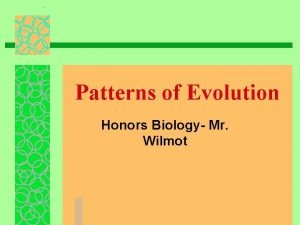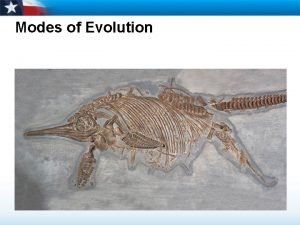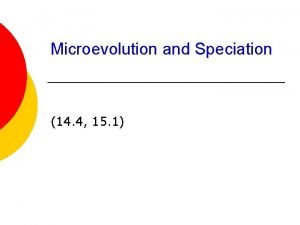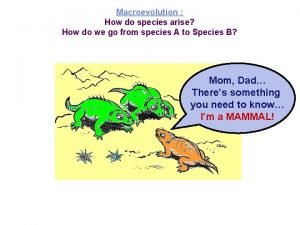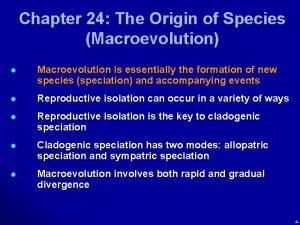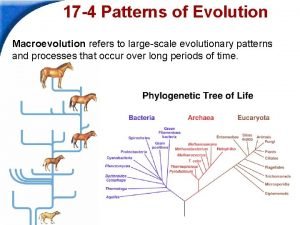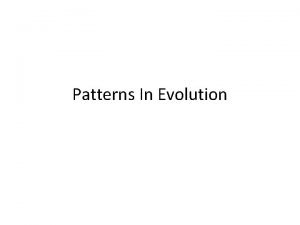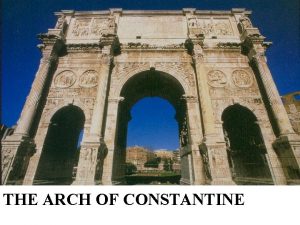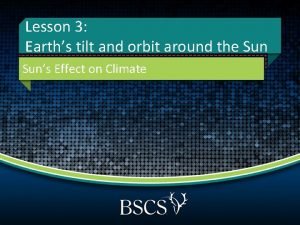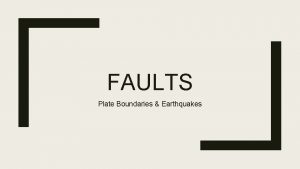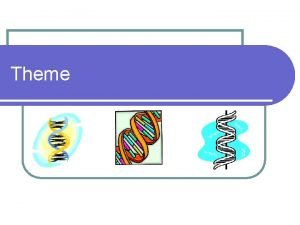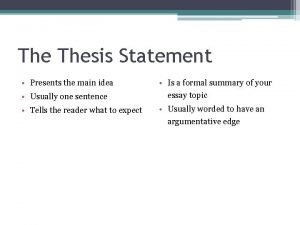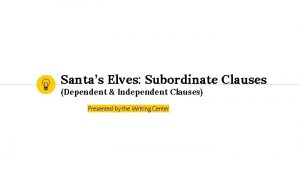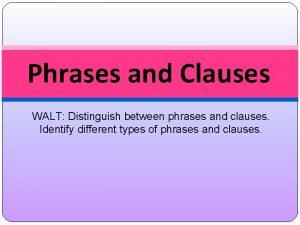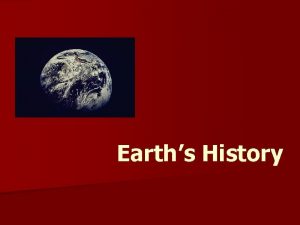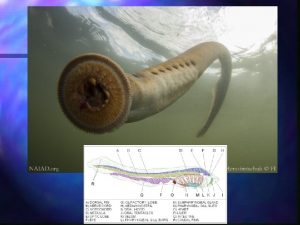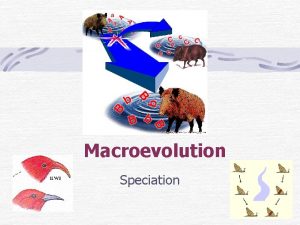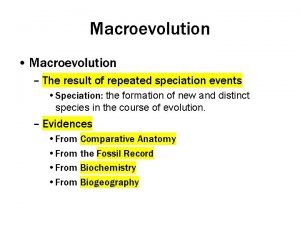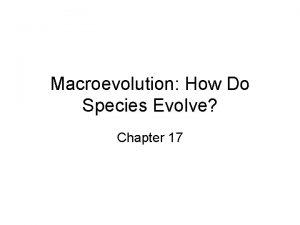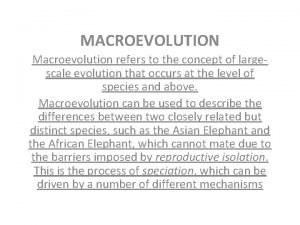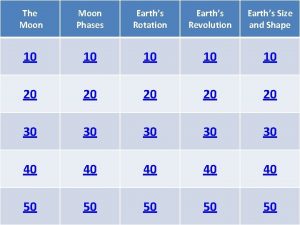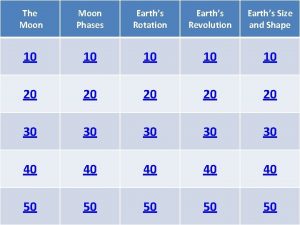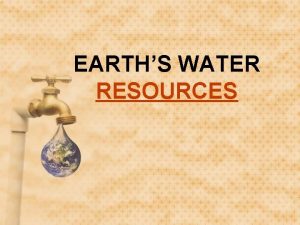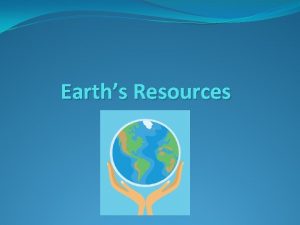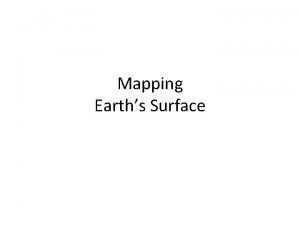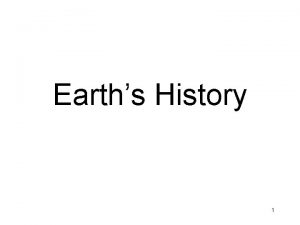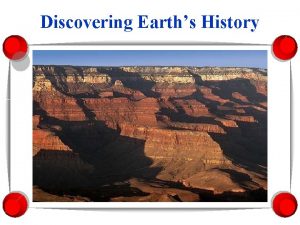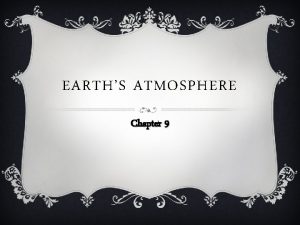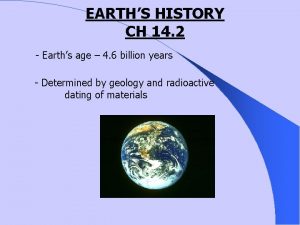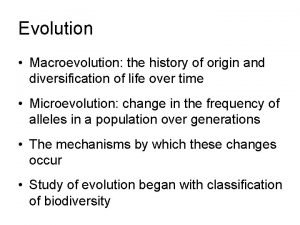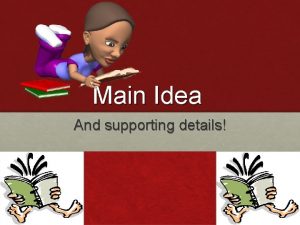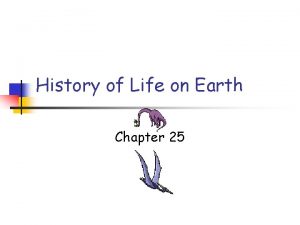MACROEVOLUTION AND EARTHS HISTORY Macroevolution is the main
























































































- Slides: 88


MACROEVOLUTION AND EARTH'S HISTORY Macroevolution is the main event in the evolutionary history of life on Earth • Documented in the fossil record • The geologic record is based on the sequence of fossils • Earth's history divided into three eons • Within the most recent eon, eras and periods marked by mass or lesser extinctions

• Some major events in the history of life • Precambrian period: oldest known fossilsprokaryotes from 3. 5 billion years ago • Paleozoic era: lineages that gave rise to modern life forms • Mesozoic era: age of reptiles, including dinosaurs • Cenozoic era: Explosive evolution of mammals, birds, and flowering plants


Radiometric dating can gauge the actual ages of fossils and the rocks in which they are found • Based on the decay time of radioactive isotopes relative to other isotopes • Carbon-14 for relatively young fossils • Isotopes with longer half-lives for older fossils

Continental drift has played a major role in macroevolution • Continental drift is the slow, incessant movement of Earth's crustal plates on the hot mantle • World geography changes constantly

LE 15 -03 a Eurasian Plate North American Plate Arabian Plate Pacific Plate Nazca Plate South American Plate African Plate Indian Plate Split developing Australian Plate Antarctic Plate Edge of one plate being pushed over edge of neighboring plate (zones of violent geologic events)

• Continental movements have greatly influenced the distribution of organisms around the world • Formation of Pangaea 250 million years ago altered habitats and triggered extinctions • Breakup of Pangea beginning 180 million years ago created a number of separate evolutionary arenas • Explains the geographical distribution of diverse life forms • Examples: marsupials, lungfishes

LE 15 -03 b Cenozoic 0 ca eri m h. A rt No 65 South America Eurasia Africa st Au Laurasia 135 Mesozoic Go nd wa 251 aea Paleozoic ng Pa ia ral Antarctica Millions of years ago India na


LE 15 -03 d North America Asia Europe Africa South America Australia = Living lungfishes = Fossilized lungfishes

CONNECTION Plate tectonics are the forces involved in movements of Earth's crustal plates • The geologic processes that result include volcanoes and earthquakes • Can create devastation or opportunities for organisms • The boundaries of plates are hot spots of such geologic activity

LE 15 -04 a San Andreas Fault North American Plate San Francisco Santa Cruz Pacific Plate Los Angeles California

15. 5 Mass extinctions were followed by diversification of life-forms • Extinctions occur all the time, but extinction rates have not been steady • Over the last 600 million years, at least six periods of mass extinctions have occurred, including • Permian extinction (250 million years ago); claimed 96% of aquatic life • Cretaceous extinction (65 million years ago); eliminated dinosaurs

• Cause of mass extinctions is unclear • Permian extinction occurred at a time of enormous volcanic explosions • Cretaceous extinction may have been caused by an asteroid • Mass extinctions have been followed by an explosive increase in diversity • Provide surviving organisms with new environmental opportunities • Example: rise of mammals after extinction of dinosaurs

LE 15 -05 North America ¢ Yucatan Peninsula Chicxulub crater ¢ Yucatan Peninsula

BINOMIAL NOMENCLATURE -Naming system used today -Formed by Linnaeus -Name an organism using the Genus and species *Homo sapiens -WHY? ? -Aristotle was the first to classify *classified as either plant or animal *divided further into: land, water, or air dwellers *plant classification was based on their stems

WHY Bionomial Nomenclature? -Early scientists used common names which caused confusion Ex: robin, pine tree -Everyday names may not accurately describe the organism Ex: Jellyfish is not a fish, not made of jelly -Can name many species with one name Ex: Maple tree …. . Sugar Maple, Red Maple, Silver Maple Using Genus & species if known as the SCIENTIFIC NAME *Describes organism *Ex: Trifolium agrarium -3 -leaved and found in fields

KINGDOMS 1. MONERA -prokaryotic -Asexual reproduction -Includes greatest number of living things on Earth EX: bacteria 2. PROTISTA -eukaryotic without specialized tissue systems -ingest food -aquatic, moist habitats EX: Algae 3. FUNGI -heterotrophic organisms -absorb nutrients -most are terrestrial -EX: Yeast, mushrooms

KINGDOMS (cont. ) 4. PLANTAE -all plants -eukaryotic/muticellular -photosynthetic EX: mosses, tress, flowers, shrubs 5. ANIMALIA -Eukaryotic, multicelluar -Ingest food -Sexual reproduction, few asexually EX: spiders, elephants, humans

Clown, Fool, or Simply Well Adapted? • The blue-footed booby has many specialized characteristics that are very functional in water but less useful on land • Such evolutionary adaptations are inherited traits that enhance an organism's ability to survive and reproduce in its particular environment • Evolution is the changes in organisms over time


DARWIN'S THEORY OF EVOLUTION A sea voyage helped Darwin frame his theory of evolution • Pre-Darwinian ideas about the origin of species • Early Greek philosophers: Simpler life forms preceded more complex ones • Aristotle: Species are fixed and do not evolve; had a great impact on Western thinking • Judeo-Christian biblical view: All species were individually designed by a divine creator

• In the century prior to Darwin, only a few scientists questioned the belief that species are fixed • Buffon: The study of fossils suggested that Earth is older than 6, 000 years, and fossil forms might be early versions of modern forms • Lamarck: Fossils are related to modern forms because life evolves; acquired characteristics are inherited

• Charles Darwin made a round-the-world sea voyage as a naturalist on HMS Beagle in the 1830 s • Darwin observed similarities between living and fossil organisms and the diversity of life on the Galápagos Islands • Darwin's experiences during the voyage helped him frame his ideas about evolution

Marine Iguana …. . Galapagos Islands

LE 13 -1 b Great Britain Europe Asia North America ATLANTIC OCEAN PACIFIC OCEAN Pinta Marchena Genovesa Equator Santiago Pinzón Fernandina Isabela 0 0 40 km Daphne Islands Santa Cruz Fe Florenza 40 miles San Cristobal Española PACIFIC OCEAN Equator South America Australia Andes The Galápagos Islands Africa Cape of Good Hope Cape Horn Tierra del Fuego Tasmania New Zealand

• After his return, Darwin began to document his observations and his new theory of evolution • Darwin's On the Origin of Species by Means of Natural Selection was published in 1859

• "Descent with modification" summarizes Darwin's view of life • All organisms are related through descent from a remote common ancestor • Descendants spread into diverse habitats over millions of years and acquired adaptations to their environments • The history of life resembles a tree with multiple branchings from a common trunk • Species that are closely related share characteristics

Darwin proposed natural selection as the mechanism of evolution • The essence of Darwin's theory of natural selection is differential success in reproduction • Organisms produce more offspring than the environment can support • Organisms vary in many characteristics that can be inherited • Excessive numbers of organisms lead to a struggle for survival

• Individuals whose characteristics are best adapted to their environment are more likely to survive and reproduce • The unequal ability of individuals to survive and reproduce leads to a gradual change in the characteristics of a population over generations • Natural selection is supported by evidence from artificial selection

Vegetables are all derived from wild mustard plant

LE 13 -2 c African wild dog Coyote Wolf Thousands to millions of years of natural selection Ancestral canine Fox Jackal

The study of fossils provides strong evidence for evolution • Fossils are the hard parts of organisms that remain after organic materials decay • Rarely, an entire organism is fossilized • The fossil record strongly supports theory of evolution • Changes in sea level and drying and refilling of lakes over time result in rock strata that trap organisms

• Fossils appear in an ordered array within layers of sedimentary rocks • The fossil record reveals that organisms have evolved in a historical sequence • Many fossils link early extinct species with species living today










13. 4 A mass of other evidence reinforces the evolutionary view of life • Biogeography • The geographic distribution of species suggested to Darwin that organisms evolve from common ancestors • Isolated organisms resemble each other more than organisms in similar but distant places

• Comparative anatomy • Homologous structures are features that often have different functions but are structurally similar because of common ancestry • Vestigial structures are remnants of structures that served important functions in an organism's ancestors

LE 13 -4 a Human Cat Whale Bat

• Comparative embryology • Common embryonic structures in all vertebrates are evidence for common descent

LE 13 -4 b Pharyngeal pouches Post-anal tail Chick embryo Human embryo

• Molecular biology • Comparisons of DNA and amino acid sequences between different organisms reveal evolutionary relationships • Molecular biology provides strong evidence that all life forms are related


CONNECTION 13. 5 Scientists can observe natural selection in action • Examples of evolutionary adaptation observed over a short time • Different camouflage adaptations in different environments • Development of pesticide resistance in insects Video: Seahorse Camouflage


LE 13 -5 b Chromosome with gene conferring resistance to pesticide Additional applications of the same pesticide will be less effective, and the frequency of resistant insects in the population will grow Pesticide application Survivor

• Examples of evolutionary adaptation reveal three key points about natural selection • Natural selection is more of an editing process than a creative mechanism • Natural selection is contingent on time and place • Significant evolutionary change can occur in a short time

POPULATION GENETICS AND THE MODERN SYNTHESIS • 13. 6 Populations are the units of evolution • Population • A group of individuals of the same species living in the same place at the same time • May be isolated from other groups or concentrated • The smallest unit that can evolve Copyright © 2005 Pearson Education, Inc. publishing as Benjamin Cummings


• Population genetics • Combines Darwin's and Mendel's ideas in studying how populations change genetically over time • The modern synthesis • Connects population genetics with other sciences • Focuses on population as the unit of evolution and central role of natural selection

• Studying evolution at the population level • Evolution: change in the prevalence of certain heritable characteristics in a population over a span of generations • Gene pool: the total collection of genes in a population at any one time • Microevolution: a change in the relative frequencies of alleles in a gene pool • Species: a group of populations capable of interbreeding and producing fertile offspring

13. 7 The gene pool of a nonevolving population remains constant over the generations • In a nonevolving population, the shuffling of alleles that accompanies sexual reproduction does not alter the genetic makeup of the population • In Hardy-Weinberg equilibrium, the frequency of each allele in the gene pool will remain constant unless acted upon by other agents

• For a population to be in Hardy-Weinberg equilibrium, it must satisfy five main conditions • The population is very large • The population is isolated • Mutations do not alter the gene pool • Mating is random • All individuals are equal in reproductive success

• The Hardy-Weinberg conditions are rarely met in nature • We can follow alleles in a population to observe if Hardy-Weinberg equilibrium exists • Hardy-Weinberg equilibrium provides a basis for understanding how populations evolve

LE 13 -7 a Webbing No webbing

LE 13 -7 b Phenotypes Genotypes WW Ww ww Number of animals (total = 500) 320 160 20 Genotype frequencies 320 500 160 500 = 0. 64 Number of alleles in gene pool (total = 1, 000) 640 W Allele frequencies 800 1, 000 = 0. 32 160 W + 160 w = 0. 8 W 200 1, 000 20 500 40 w = 0. 2 w = 0. 04

LE 13 -7 c Recombination of alleles from parent generation Sperm W egg p = 0. 8 W sperm p = 0. 8 w sperm q = 0. 2 WW p 2 = 0. 64 Ww pq = 0. 16 w. W qp = 0. 16 q 2 Eggs w egg q = 0. 2 ww = 0. 04 Next generation: Genotype frequencies Allele frequencies 0. 64 WW 0. 8 W 0. 32 Ww 0. 04 ww 0. 2 w

CONNECTION 13. 8 The Hardy-Weinberg equation is useful in public health science • Public health scientists use the Hardy-Weinberg equation to estimate frequencies of disease-causing alleles in the human population • Example: phenylketonuria (PKU)

13. 9 In addition to natural selection, genetic drift and gene flow can contribute to evolution • Genetic drift: change in the gene pool of a population due to chance • Can alter allele frequencies in a population • The smaller the population, the greater the impact • Bottleneck effect: an event that drastically reduces population size • Founder effect: colonization of a new location by a small number of individuals

LE 13 -9 a Original population Bottlenecking event Surviving population


• Gene flow: the movement of individuals or gametes between populations • Can alter allele frequencies in a population • Tends to reduce differences between populations • Natural selection • Best-adapted individuals have the most reproductive success • Results in accumulation of traits that adapt a population to its environment

CONNECTION 13. 10 Endangered species often have reduced variation • Loss of genetic variability due to bottlenecking may reduce a population's ability to adapt to environmental change • Particularly threatening to endangered species such as the cheetah

VARIATION AND NATURAL 13. 11 Variation is extensive in most populations • SELECTION Individual variation exists in all sexually reproducing populations • Heritable variation results from a combination of genotype and environmental influences • Polymorphism: two or more forms of phenotypic characteristics • Geographic variation: variation of an inherited characteristic from place to place • May occur along a geographic continuum (a cline)


13. 12 Mutation and sexual recombination generate variation • Mutations-changes in the nucleotide sequence of DNA-can create new alleles • Only mutations in cells that produce gametes can affect a population's gene pool • A mutation may rarely improve adaptation to the environment and thus contribute to evolution • Sexual recombination generates variation by shuffling alleles during meiosis

LE 13 -12 a A 1 Parents A 2 A 1 A 3 Meiosis A 1 Gametes A 2 A 3

LE 13 -12 b A 1 A 2 A 3 Gametes Fertilization Offspring, with new combinations of alleles A 1 A 2 and A 3

CONNECTION 13. 13 The evolution of antibiotic resistance in bacteria is a serious public health concern • Natural selection has led to the evolution of antibiotic-resistant bacteria • Overuse and misuse of antibiotics has contributed to the proliferation of antibiotic-resistant strains • Example: tuberculosis


13. 14 Diploidy and balancing selection preserve variation • Diploidy (two sets of chromosomes) helps to prevent populations from becoming genetically uniform • Recessive alleles are "hidden" from natural selection and remain in the population

• Balancing selection allows two or more phenotypic forms in a population • Balanced polymorphism may result from • Heterozygote advantage; example: sickle-cell disease • Frequency-dependent selection • Neutral variation provides no apparent advantage or disadvantage • Example: fingerprints


13. 15 The perpetuation of genes defines evolutionary fitness • Evolutionary fitness is the relative contribution an individual makes to the gene pool of the next generation • Survival of genes depends on production of fertile offspring • Selection indirectly adapts a population to its environment by acting on phenotype

13. 16 Natural selection can alter variation in a population in three ways • Stabilizing selection: favors intermediate phenotypes • Directional selection: acts against individuals at one of the phenotypic extremes • Disruptive selection: favors individuals at both extremes of the phenotypic range

Frequency of individuals LE 13 -16 Original population Phenotypes (fur color) Original population Evolved population Stabilizing selection Directional selection Disruptive selection

13. 17 Sexual selection may produce sexual dimorphism • Sexual dimorphism • The distinction in appearance between males and females of a species • Sexual selection • The determining of "who mates with whom" • Leads to the evolution of secondary sexual characteristics that may give individuals an advantage in mating



13. 18 Natural selection cannot fashion perfect organisms • There at least four reasons why natural selection cannot produce perfection • Organisms are limited by historical constraints • Adaptations are often compromises • Chance and natural selection interact • Selection can only edit existing variations
 Macroevolution 7 patterns
Macroevolution 7 patterns Macroevolution definition
Macroevolution definition Microevolution
Microevolution Types of speciation
Types of speciation Difference between prezygotic and postzygotic barriers
Difference between prezygotic and postzygotic barriers New concept chapter 19
New concept chapter 19 Section 17-4 patterns of evolution answer key
Section 17-4 patterns of evolution answer key What are the two major patterns of evolution?
What are the two major patterns of evolution? The earths layer foldable
The earths layer foldable Earths roation
Earths roation Whats earths moon called
Whats earths moon called Earths biomes
Earths biomes Periodic table of elements families
Periodic table of elements families Basalt
Basalt Whats earths moon called
Whats earths moon called Whats the thickest layer of the earth
Whats the thickest layer of the earth Earths early atmosphere contained
Earths early atmosphere contained The earth's layers foldable
The earth's layers foldable Earths major crustal plates
Earths major crustal plates Earths orbit seasons
Earths orbit seasons Brown earth soil profile
Brown earth soil profile Study of the earth's physical features
Study of the earth's physical features Honey as fertilizer
Honey as fertilizer Whats the name of earths moon
Whats the name of earths moon Pangea explanation
Pangea explanation Earths crust
Earths crust Earths interior
Earths interior What does the earths tilt cause
What does the earths tilt cause Earth's atmosphere description
Earth's atmosphere description What's the shape of earth's orbit
What's the shape of earth's orbit Arch of constantine dimensions
Arch of constantine dimensions What does earths tilt do
What does earths tilt do Earths boundaries
Earths boundaries 4 spheres of the earth
4 spheres of the earth Stated and implied main idea
Stated and implied main idea Be going to
Be going to Void main int main
Void main int main Hình ảnh bộ gõ cơ thể búng tay
Hình ảnh bộ gõ cơ thể búng tay Ng-html
Ng-html Bổ thể
Bổ thể Tỉ lệ cơ thể trẻ em
Tỉ lệ cơ thể trẻ em Voi kéo gỗ như thế nào
Voi kéo gỗ như thế nào Tư thế worms-breton
Tư thế worms-breton Chúa yêu trần thế alleluia
Chúa yêu trần thế alleluia Môn thể thao bắt đầu bằng chữ f
Môn thể thao bắt đầu bằng chữ f Thế nào là hệ số cao nhất
Thế nào là hệ số cao nhất Các châu lục và đại dương trên thế giới
Các châu lục và đại dương trên thế giới Công thức tính thế năng
Công thức tính thế năng Trời xanh đây là của chúng ta thể thơ
Trời xanh đây là của chúng ta thể thơ Cách giải mật thư tọa độ
Cách giải mật thư tọa độ Làm thế nào để 102-1=99
Làm thế nào để 102-1=99 độ dài liên kết
độ dài liên kết Các châu lục và đại dương trên thế giới
Các châu lục và đại dương trên thế giới Thơ thất ngôn tứ tuyệt đường luật
Thơ thất ngôn tứ tuyệt đường luật Quá trình desamine hóa có thể tạo ra
Quá trình desamine hóa có thể tạo ra Một số thể thơ truyền thống
Một số thể thơ truyền thống Cái miệng nó xinh thế
Cái miệng nó xinh thế Vẽ hình chiếu vuông góc của vật thể sau
Vẽ hình chiếu vuông góc của vật thể sau Thế nào là sự mỏi cơ
Thế nào là sự mỏi cơ đặc điểm cơ thể của người tối cổ
đặc điểm cơ thể của người tối cổ V cc cc
V cc cc Vẽ hình chiếu đứng bằng cạnh của vật thể
Vẽ hình chiếu đứng bằng cạnh của vật thể Fecboak
Fecboak Thẻ vin
Thẻ vin đại từ thay thế
đại từ thay thế điện thế nghỉ
điện thế nghỉ Tư thế ngồi viết
Tư thế ngồi viết Diễn thế sinh thái là
Diễn thế sinh thái là Các loại đột biến cấu trúc nhiễm sắc thể
Các loại đột biến cấu trúc nhiễm sắc thể Bảng số nguyên tố
Bảng số nguyên tố Tư thế ngồi viết
Tư thế ngồi viết Lời thề hippocrates
Lời thề hippocrates Thiếu nhi thế giới liên hoan
Thiếu nhi thế giới liên hoan ưu thế lai là gì
ưu thế lai là gì Khi nào hổ con có thể sống độc lập
Khi nào hổ con có thể sống độc lập Khi nào hổ con có thể sống độc lập
Khi nào hổ con có thể sống độc lập Hệ hô hấp
Hệ hô hấp Từ ngữ thể hiện lòng nhân hậu
Từ ngữ thể hiện lòng nhân hậu Thế nào là mạng điện lắp đặt kiểu nổi
Thế nào là mạng điện lắp đặt kiểu nổi History also history physical
History also history physical Topic sentence structure
Topic sentence structure Main idea vs theme
Main idea vs theme How do you find the central idea of a text?
How do you find the central idea of a text? Thesis main idea
Thesis main idea 12 main greek gods
12 main greek gods Subordinate clause
Subordinate clause Batch sequential architecture
Batch sequential architecture Main clause and subordinate clause
Main clause and subordinate clause Phrase vs clause
Phrase vs clause
